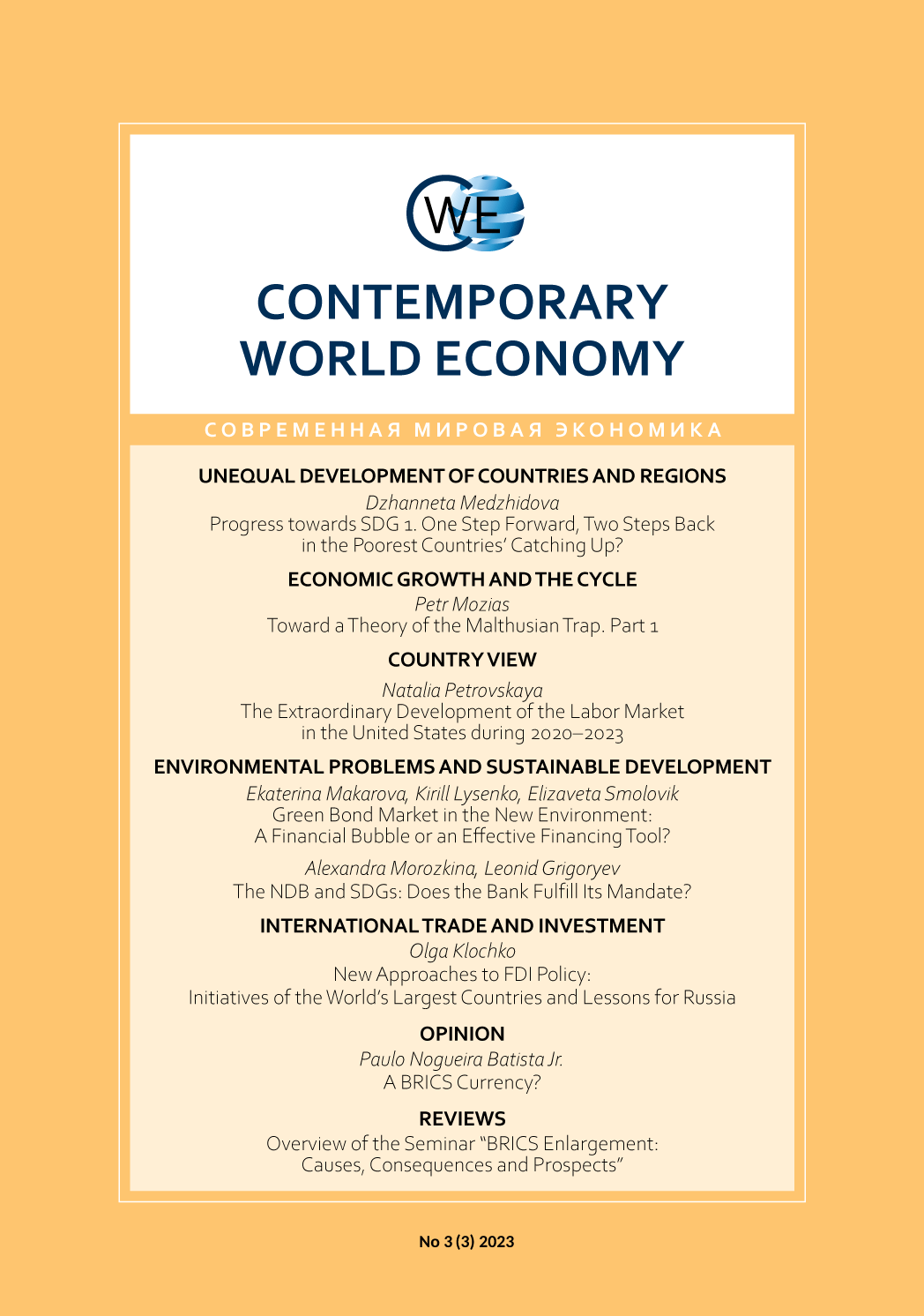Green Bond Market in the New Context: A Financial Bubble or an Effective Financing Tool?
Abstract
Ensuring economic growth in the 21st century is inextricably linked to attempts to address pressing human development challenges, including poverty and inequality, climate change, accelerating ecosystem degradation and other environmental concerns. The concept of corporate social responsibility (CSR) has gradually transformed into an ESG approach, which is largely synchronized with the internationally benchmarked Sustainable Development Goals. The growing popularity of this approach was also reflected in the development of the financial market and financial institutions, which responded with the first issue of green bonds in 2007. One of the drivers of the subsequent growth of this segment of the financial market was a high green premium, which persisted until the crisis events of the early 2020s. The challenges facing the global economy in 2022 had a negative impact on the dynamics and state of the green securities segment and led to the disappearance of the green premium in the fourth quarter of 2022. In the coming years, we can expect the market to recover, as well as its transition to a new state, including through changes in the structure of green bond issuers.
Downloads
References
Agliardi, E., Agliardi, R., 2019. Financing environmentally-sustainable projects with green bonds. Environment and Development Economics. No 6. Available at: https://www.cambridge.org/core/journals/environment-and-development-economics/article/abs/financing-environmentallysustainable-projects-with-green-bonds/AF17C83137370EC47C500414468EDEC6 (accessed 26 June 2023).
Akitaka, T., Kenichi, S., 2023. Recent Characteristics of Long-Term Interest Rates and Stock Prices in the United States and Europe: With a Focus on the Effects of Increased Attention to Inflation Indicators. Available at: https://www.boj.or.jp/en/research/wps_rev/rev_2023/data/rev23e06.pdf (accessed 08 September 2023).
Alonso-Conde, A.-B., Rojo-Suárez, J., 2020. On the Effect of Green Bonds on the Profitability and Credit Quality of Project Financing. Sustainability. Available at: https://www.mdpi.com/2071-1050/12/16/6695 (accessed 21 June 2023).
Ando, S., Roch, F., Wiriadinata, U., Fuhttps, C., 2023. Sovereign Climate Debt Instruments: An Overview of the Green and Catastrophe Bond Markets. Available at: https://www.imf.org/en/Publications/staff-climate-notes/Issues/2022/06/29/Sovereign-Climate-Debt-Instruments-An-Overview-of-the-Green-and-Catastrophe-Bond-Markets-518272 (accessed 04 August 2023).
Asian Development Bank, 2022. Carbon pricing for energy transition.
Azevedo, M. et al., 2022. Capturing the green-premium value from sustainable materials. McKinsey & Company. Available at: https://www.mckinsey.com/industries/metals-and-mining/our-insights/capturing-the-green-premium-value-from-sustainable-materials#/ (accessed 19 July 2023).
Babkin, A. V., Malevskaia-Malevich, E. D., 2021. Impact of socially responsible investment on the cost of innovatively active industrial enterprises. St.Petersburg State Polytechnical University Journal. Economics. No 4. P. 82-94 (in Russian).
Bloomberg, 2023. Global Bond Sales Off to Record Start of Nearly $600 Billion. Available at: https://www.bloomberg.com/news/articles/2023-01-19/global-bond-sales-surge-to-record-start-of-year-at-586-billion#xj4y7vzkg (accessed 21 June 2023).
BloombergNEF, 2023. Global Low-Carbon Energy Technology Investment Surges Past $1 Trillion for the First Time. 26 January 2023. Available at: https://about.bnef.com/blog/global-low-carbon-energy-technology-investment-surges-past-1-trillion-for-the-first-time/ (accessed 21 June 2023).
Capital Monitor, 2022. Where Europe’s cities are putting their green money. Aug.1. Available at: https://capitalmonitor.ai/sdgs/sdg-11-sustainable-cities-and-communities/sustainable-bonds-europes-municipals-green-money/ (accessed 21 June 2023).
Chase, M., 2021. Simplifying Sustainable Finance – Explaining Green Bonds, Green Loans, Sustainability-Linked Loans and Bonds and More. Sustainalytics. Available at: https://www.sustainalytics.com/esg-research/resource/corporate-esg-blog/simplifying-sustainable-finance-green-loans-vs-green-bonds-vs-sustainability-linked-loan-and-more (accessed 01 August 2023).
Chhachhar, V., Niharika, Singh, R.K., Mishra, S., Tiwari, I.D., Singh, A., 2023. Exploring the Role of Municipalities in Promoting Sustainable Development with Special Reference to Green Bonds in India. International Journal of Environmental Sciences. Vol. 9. No 2. P. 31-44.
Climate Bonds Initiative, 2022. $500bn Green Issuance 2021: social and sustainable acceleration: Annual green $1tn in sight: Market expansion forecasts for 2022 and 2025. Available at: https://www.climatebonds.net/2022/01/500bn-green-issuance-2021-social-and-sustainable-acceleration-annual-green-1tn-sight-market (accessed 27 July 2023).
Climate Bonds Initiative, n.d. Available at: https://www.climatebonds.net/market/data/ (accessed 21 June 2023).
Climate Bonds Initiative. Explaining Green Bonds. Available at: https://www.climatebonds.net/market/explaining-green-bonds
Daubanes, J. X., Mitali, S. F., Rochet, J. C., 2021. Why do firms issue green bonds? Swiss Finance Institute Research Paper. 2021. No 21-97. Available at: https://papers.ssrn.com/sol3/papers.cfm?abstract_id=3996238 (accessed 05 July 2023).
Dorofeev, M. L., 2020. Distinctive Features of Cost of Capital on Green Bond Market. . ECO. No 5. P. 62-76 (in Russian).
Edelman, 2018. Edelman Trust Barometer. Available at: https://www.edelman.com/sites/g/files/aatuss191/files/2018-11/Edelman_Trust_Baromter_Institutional_Investor_US_Results_0.pdf (accessed 21 August 2023).
Emets, M. I., 2020. Green bond premium: literature review and perspectives. Bulletin of Eurasian Science. No 2. P. 39-47 (in Russian).
European Central Bank, 2023a. The euro area bank lending survey - Fourth quarter of 2022. Available at: https://www.ecb.europa.eu/stats/ecb_surveys/bank_lending_survey/html/ecb.blssurvey2022q4~e27b836c04.en.html (accessed 13 July 2023).
European Central Bank, 2023b. The euro area bank lending survey. Available at: https://www.ecb.europa.eu/stats/ecb_surveys/bank_lending_survey/html/ecb.blssurvey2022q2~ce6d1a4597.en.html (accessed 21 June 2023).
Financial Research Institute, 2016. Comparative analysis of financing mechanisms for “green” and “dirty” investment projects. Available at: https://minfin.gov.ru/common/upload/library/2018/06/main/2016_part_1.pdf (accessed 21 June 2023) (in Russian).
Flammer, C., 2021. Corporate green bonds. Journal of Financial Economics. No 2. Available at: https://www.sciencedirect.com/science/article/pii/S0304405X21000337 (accessed 15 July 2023).
García-Lamarca, M., Ullström S., 2022. “Everyone wants this market to grow”: The affective post-politics of municipal green bonds. Environment and Planning E: Nature and Space. Vol. 5(1). P. 207-224.
Gardiner, J., Freke, T., 2023. Green bonds boom in first half of 2023. July 27. Available at: https://www.bloomberg.com/professional/blog/green-bonds-boom-in-first-half-of-2023/
Gates, B., 2021. A green premium. Time. Vol. 18. No 4. P. 90-92.
Geels, F., Pereira, G., Pinkse, J., 2021. Public investments in COVID-19 green recovery packages: A comparative analysis of scale, scope, and implementation in France, Germany, and the United Kingdom. The Productivity Institute. Available at: https://www.productivity.ac.uk/wp-content/uploads/2021/06/Public-investments-in-COVID19-green-recovery-packages-FINAL.pdf (accessed 19 June 2023).
Godfrey, P.C., 2005. The relationship between corporate philanthropy and shareholder wealth: A risk management perspective. Academy of Management Review. No 4. P. 777-798.
Gorelick, J., 2018. Supporting the future of municipal bonds in sub-Saharan Africa: the centrality of enabling environments and regulatory frameworks. Environment & Urbanization. Vol. 30(1). P. 103-122.
Han, Y., Li, J., 2022. Should investors include green bonds in their portfolios? Evidence for the USA and Europe. International Review of Financial Analysis. Available at: https://www.sciencedirect.com/science/article/abs/pii/S1057521921003136 (accessed 19 June 2023).
Hilbrandt, H., Grubbauer, M., 2020. Standards and SSOs in the contested widening and deepening of financial markets: The arrival of Green Municipal Bonds in Mexico City. EPA: Economy and Space. Vol. 52(7). P. 1415-1433.
Hilinsky, E., 2023. How ESG factors affect bond prices and yields. Available at: http://review.cbonds.info/article/magazines/5409/ (accessed 03 July 2023) (in Russian).
ICMA, 2021a. Green Bond Principles Voluntary Process Guidelines for Issuing Green Bonds. Available at: https://www.icmagroup.org/assets/documents/Sustainable-finance/2021-updates/Green-BondPrinciples-June-2021-140621.pdf (accessed 08 July 2023).
ICMA, 2021b. Principles of green bonds. Available at: https://www.icmagroup.org/assets/documents/Sustainable-finance/Translations/Russian-GBP_2021-06v2-100222.pdf (accessed 15 June 2023) (in Russian).
Ivashkovskaya, I., Mikhaylova, A., 2020. Do Investors Pay Yield Premiums on Green Bonds? Journal of Corporate Finance Research. Vol. 14. No 2. P. 7-21.
Jian, J., Fan, X., Zhao, S., 2022. The green incentives and green bonds financing under the belt and road initiative. Emerging Markets Finance and Trade. No 5. Available at: https://www.tandfonline.com/doi/full/10.1080/1540496X.2021.1887726?scroll=top&needAccess=true (accessed 01 July 2023).
Khmyz, O. V., 2019. International experience of issuing "green" bonds. Available at: https://cyberleninka.ru/article/n/mezhdunarodnyy-opyt-vypuska-zelenyh-obligatsiy (accessed 17 July 2023) (in Russian).
MacAskill, S. et al., 2021. Is there a green premium in the green bond market? Systematic literature review revealing premium determinants. Journal of Cleaner Production. No 280. P. 1-12.
Maltais, A., Nykvist, B., 2020. Understanding the role of green bonds in advancing sustainability. Journal of Sustainable Finance & Investment. Available at: https://www.tandfonline.com/doi/full/10.1080/20430795.2020.1724864 (accessed 19 July 2023).
Miller, N., Spivey, J., Florance, A., 2008. Does green pay off? Journal of Real Estate Portfolio Management. No 4. P. 385-400.
Partridge, C., Medda, F., 2018. Green premium in the primary and secondary US municipal bond markets. SSRN. Available: https://papers.ssrn.com/sol3/papers.cfm?abstract_id=3237032 (accessed 04 August 2023).
Pietch, A., Salakhova, D., 2022. Pricing of green bonds: drivers and dynamics of the greenium. ECB Working Paper No. 2022/2728. Available at: https://www.ecb.europa.eu/pub/pdf/scpwps/ecb.wp2728~7baba8097e.en.pdf
Ravina, A., 2022. On bond returns in a time of climate change. The Energy Journal. No 1. P. 139-159.
Ul Haq, I., Doumbia, D., 2022. Structural Loopholes in Sustainability-Linked Bonds. The World Bank. Available at: https://documents1.worldbank.org/curated/en/099237410062223046/pdf/IDU0e099a50307f86045a80b33201d0b7057cedf.pdf (accessed 06 July 2023).
Wass, S., Isjwara, Wu, J., Ahmad, R., 2022. Europe’s dominance in green bond market fades amid record growth in China. Available at: https://www.spglobal.com/marketintelligence/en/news-insights/latest-news-headlines/europe-s-dominance-in-green-bond-market-fades-amid-record-growth-in-china-71321575.
Wass, S., Wu, J., Yamaguchi, Y., Ramos, M., 2023. Global green bond issuance poised for rebound in 2023 amid policy push. Available at: https://www.spglobal.com/marketintelligence/en/news-insights/latest-news-headlines/global-green-bond-issuance-poised-for-rebound-in-2023-amid-policy-push-73931433 (accessed 04 August 2023).
Where Europe’s cities are putting their green money. 2022. Capital Monitor. Aug. 1. Available at: https://capitalmonitor.ai/sdgs/sdg-11-sustainable-cities-and-communities/sustainable-bonds-europes-municipals-green-money/ (accessed 21 June 2023).
Windflix, 2023. Investments in wind energy are down — Europe must get market design and green industrial policy right. Available at: https://windeurope.org/newsroom/press-releases/investments-in-wind-energy-are-down-europe-must-get-market-design-and-green-industrial-policy-right/ (accessed 21 June 2023).
World Bank, 2017. Green Sukuk. Available at: https://www.worldbank.org/en/news/infographic/2017/09/19/malaysia-green-sukuk (accessed 06 July 2023).
World Bank, 2022. Sovereign green, social and sustainability bonds: unlocking the potential for emerging markets and developing economies. Available at: https://thedocs.worldbank.org/en/doc/4de3839b85c57eb958dd207fad132f8e-0340012022/original/WB-GSS-Bonds-Survey-Report.pdf (accessed 30 June 2023).
Zhang, Y., Umair, M., 2023. Examining the interconnectedness of green finance: an analysis of dynamic spillover effects among green bonds, renewable energy, and carbon markets. Environmental Science and Pollution Research. No 30. P. 77605-77621.



1.jpg)

